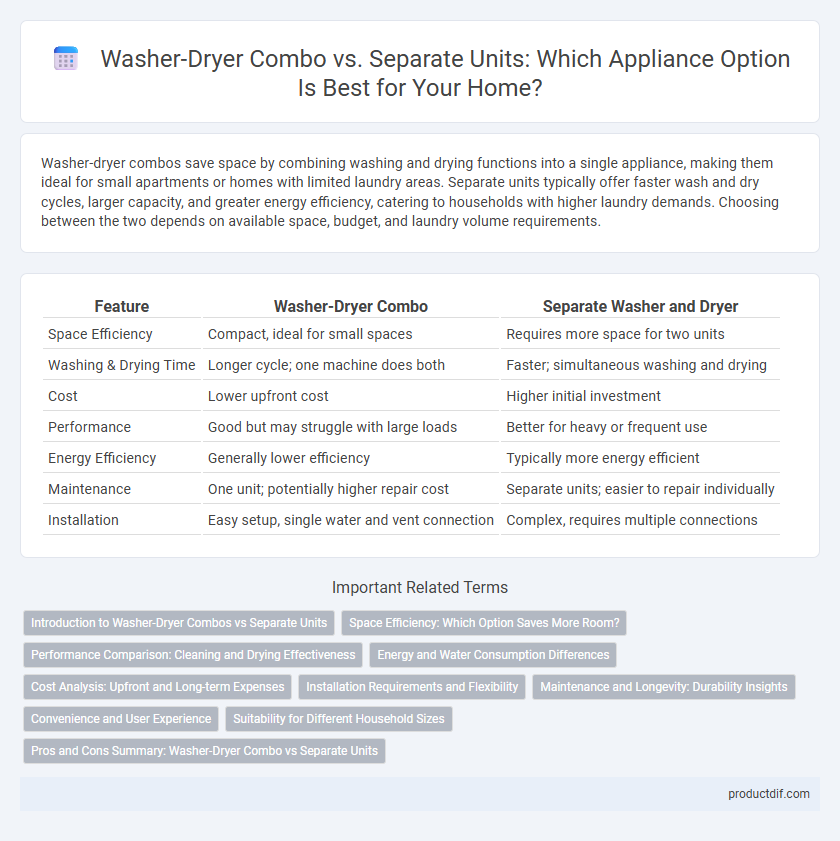Washer-dryer combos save space by combining washing and drying functions into a single appliance, making them ideal for small apartments or homes with limited laundry areas. Separate units typically offer faster wash and dry cycles, larger capacity, and greater energy efficiency, catering to households with higher laundry demands. Choosing between the two depends on available space, budget, and laundry volume requirements.
Table of Comparison
| Feature | Washer-Dryer Combo | Separate Washer and Dryer |
|---|---|---|
| Space Efficiency | Compact, ideal for small spaces | Requires more space for two units |
| Washing & Drying Time | Longer cycle; one machine does both | Faster; simultaneous washing and drying |
| Cost | Lower upfront cost | Higher initial investment |
| Performance | Good but may struggle with large loads | Better for heavy or frequent use |
| Energy Efficiency | Generally lower efficiency | Typically more energy efficient |
| Maintenance | One unit; potentially higher repair cost | Separate units; easier to repair individually |
| Installation | Easy setup, single water and vent connection | Complex, requires multiple connections |
Introduction to Washer-Dryer Combos vs Separate Units
Washer-dryer combos integrate washing and drying functions within a single appliance, offering space-saving convenience ideal for compact living areas. Separate washer and dryer units provide specialized performance, often with larger capacities and faster drying cycles tailored for high-volume laundry needs. Choosing between these options depends on factors such as available space, laundry frequency, and desired efficiency.
Space Efficiency: Which Option Saves More Room?
A washer-dryer combo saves significant floor space by combining two appliances into one, making it ideal for small apartments and tight laundry areas. Separate units require more room side-by-side or stacked, but stacked units can reduce footprint while maintaining higher capacity and faster drying times. Choosing a combo prioritizes compactness and simplicity, whereas separate units optimize performance and flexibility within allocated space.
Performance Comparison: Cleaning and Drying Effectiveness
Washer-dryer combos offer convenience but typically have lower cleaning and drying effectiveness compared to separate units, which provide more powerful wash cycles and faster, more efficient drying. Separate machines generally achieve higher spin speeds, reducing moisture levels more effectively, leading to shorter drying times and better fabric care. Performance metrics such as soil removal ratings and moisture extraction efficiency consistently favor standalone washer and dryer setups for superior laundry results.
Energy and Water Consumption Differences
Washer-dryer combos generally consume less water than separate units due to integrated wash and dry cycles using shared water systems. However, separate units often provide higher energy efficiency during drying, as dedicated dryers use optimized heating elements and ventilation. Energy Star ratings typically favor separate dryers for lower electricity consumption, while combos excel in reducing water use and space requirements.
Cost Analysis: Upfront and Long-term Expenses
Washer-dryer combos typically have a lower upfront cost compared to purchasing separate units but may result in higher long-term energy and maintenance expenses due to combined functionality. Separate washer and dryer units often require a greater initial investment yet tend to offer improved energy efficiency and durability, potentially reducing utility bills and repair costs over time. Evaluating cost analysis should consider electricity consumption, water usage, installation fees, and expected appliance lifespan to determine the most economical option for individual household needs.
Installation Requirements and Flexibility
Washer-dryer combos require a single water supply and drainage connection, simplifying installation and saving space, ideal for apartments or small homes with limited utility access. Separate units need distinct hookups for each appliance, increasing installation complexity but offering greater flexibility in placement and upgrading options. Choosing between them depends on available space, plumbing infrastructure, and future appliance preferences.
Maintenance and Longevity: Durability Insights
Washer-dryer combos generally require less space but may have more complex maintenance needs due to integrated parts that can wear out faster compared to separate units. Separate washer and dryer units often offer enhanced durability with easier access to individual components, simplifying repairs and extending appliance lifespan. Investing in high-quality brands and routine upkeep significantly improves the longevity of both combo and separate laundry appliances.
Convenience and User Experience
Washer-dryer combos streamline laundry tasks by combining washing and drying in a single machine, saving space and reducing the need for multiple hookups. Separate units offer greater flexibility with simultaneous washing and drying cycles, allowing users to manage large loads more efficiently. The choice impacts convenience based on available space, laundry volume, and user preference for multitasking versus specialized performance.
Suitability for Different Household Sizes
Washer-dryer combos are ideal for small apartments or households with limited space, offering a compact solution that saves room without sacrificing laundry functionality. Separate washer and dryer units provide greater capacity and efficiency, making them a better fit for larger families or households with frequent washing needs. Choosing between the two depends on space availability, laundry volume, and specific user convenience preferences.
Pros and Cons Summary: Washer-Dryer Combo vs Separate Units
Washer-dryer combos save space and offer convenience by combining washing and drying in one appliance, making them ideal for small living areas. Separate washer and dryer units provide better performance, larger capacity, and faster drying times but require more space and potentially higher costs. Choosing between the two depends on priorities like space, efficiency, and laundry volume.
Washer-Dryer Combo vs Separate Units Infographic

 productdif.com
productdif.com